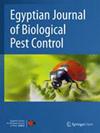Evaluation of the effectiveness of some mycorrhizal fungi isolates against charcoal rot disease
IF 2.1
3区 农林科学
Q1 ENTOMOLOGY
引用次数: 0
Abstract
Abstract Background The sunflower plants are attacked by serious seed and soil-borne pathogens including charcoal rot disease that caused by Macrophomina phaseolina . This disease has serious damages to sunflower crop. This study aimed to assess the efficacy of Arbuscular mycorrhizal fungus against charcoal rot disease as fungicide alternative. Results Morphological and molecular identification was done, using universal primers for molecular identification. Finally, a greenhouse experiment was conducted, and the length and weight of the plant shoot and root as well as disease incidence and severity percentages were estimated for the treatments infected with the M. phaseolina pathogen. The results showed that molecular identification indicates their subordination to Claroideoglomus etunicatum and Funneliformis mosseae . The greenhouse experiment showed that combined inoculation treatments ( C. etunicatum + F. mosseae and C. etunicatum + F. mosseae + M.phaseolina ) had the highest averages of length and weight of the plant shoot and root in the non-infected and pathogen-infected ( M. phaseolina ) treatments. F. mosseae and F. mosseae + M.phaseolina treatments had better effects on plant growth. M. phaseolina pathogen had suppression effects than the C. etunicatum inoculum ( C. etunicatum and C. etunicatum + M. phaseolina treatments). The disease incidence and severity percentages decreased significantly in the inoculated plants than in non-inoculated plants. F. mosseae inoculum showed more efficiency in reducing DI and DS than C. etunicatum inoculum, while adding both, resulting in an extra significant reduction. The combined inoculation, which functions as a biofungicide and a biofertilizer, presented a viable biocontrol technique for crop protection. Conclusions Such the AM fungi treatments are considered good and biological safe. The symbiotic relationship of AM fungi with plants can also be utilized to gain successful management of agricultural against soil-borne diseases for getting rid of the negative effects of pesticides.几种菌根真菌对炭腐病的防治效果评价
摘要背景向日葵植物受到严重的种子和土壤病原菌的侵害,其中包括由phaseolina Macrophomina引起的木炭腐病。该病害对向日葵作物造成严重危害。本研究旨在评价丛枝菌根真菌作为杀菌剂对炭腐病的防治效果。结果进行形态学和分子鉴定,采用通用引物进行分子鉴定。最后,通过温室试验,估算了不同处理的菜绿支原体茎、根的长、重、发病率和严重程度百分比。结果表明,它们的分子鉴定结果表明,它们隶属于衣状纹蛾和moseforis。温室试验结果表明,在未侵染和病原菌侵染的处理中,青藤+苔藓镰刀菌和青藤+苔藓镰刀菌+ phaseolina组合接种处理的植株茎部和根系的平均长度和重量最高。mosseae和F. mosseae + phaseolina处理对植物生长的影响较好。相较于黄颡鱼和黄颡鱼+黄颡鱼处理,黄颡鱼对绿颡鱼病原菌有明显的抑制作用。与未接种植株相比,接种植株的发病率和严重程度显著降低。mosseae接种物对DI和DS的降低效果优于c.etunicatum接种物,两者同时添加时,降低效果更为显著。结合接种作为生物杀菌剂和生物肥料,为作物保护提供了一种可行的生物防治技术。结论AM真菌治疗效果良好,具有生物安全性。AM真菌与植物的共生关系也可用于农业防治土传病害的成功管理,以摆脱农药的负面影响。
本文章由计算机程序翻译,如有差异,请以英文原文为准。
求助全文
约1分钟内获得全文
求助全文
来源期刊
CiteScore
4.90
自引率
16.70%
发文量
128
审稿时长
>12 weeks
期刊介绍:
The Egyptian Journal of Biological Pest Control is a periodic scientific journal published by the Egyptian Society for Biological Control of Pests (ESBCP) in collaboration with SpringerNature. The journal aims to publish internationally peer-reviewed, high-quality research articles in the field of biological and integrated pest control (non-chemical control). The journal publishes review articles, original papers, conference reports, book reviews, editorials, laboratory reports, technical notes and short communications.

 求助内容:
求助内容: 应助结果提醒方式:
应助结果提醒方式:


